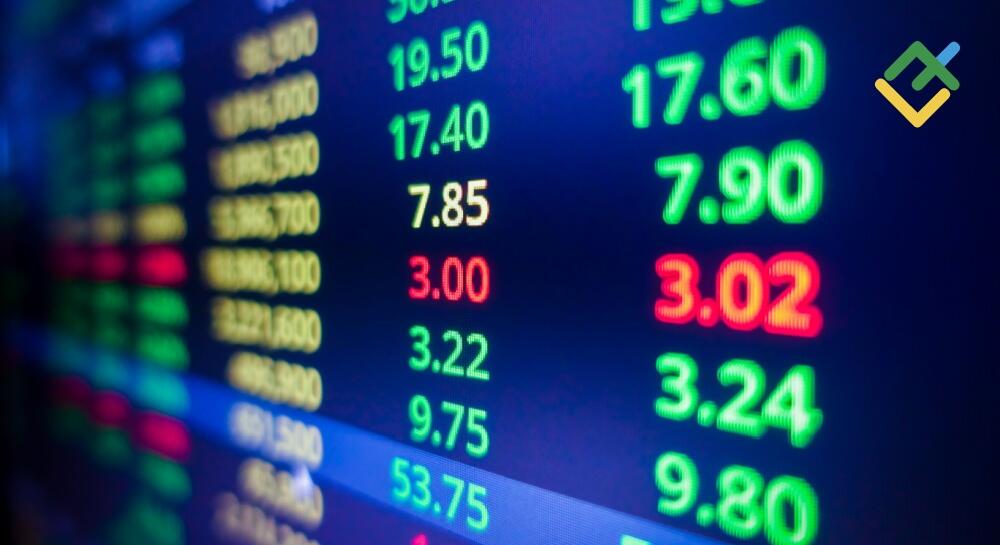Mastering Andrew’s Pitchfork: Strategies, Rules and Technical Analysis

Andrews’ Pitchfork is a chart analysis tool used to determine the trend price range.
The tool consists of a median line, along with upper and lower boundaries, which serve as support and resistance levels. Within this range, traders can identify signals for channel trading. When the price breaks through the boundaries, traders may have an opportunity to profit from a new trend.
This article will cover the rules for drawing Andrews’ Pitchfork, identifying a strong trend, and determining the boundaries of a trend channel. In the second part of the article, we will discuss methods suitable for beginners and advanced techniques for professional traders. Using Andrews’ Pitchfork in your trading strategy can significantly enhance the overall efficiency of your trading system.
The article covers the following subjects:
Key Takeaways
- Andrews Pitchfork is a chart tool used to show a price range. This range aligns with the direction of the trend, and traders can identify possible levels of support and find potential entry points within it.
- The Pitchfork highlights the trend and shows the possible boundaries of the trading channel, acting as support and resistance levels. In a downtrend, the lower line can signal a buy opportunity; in an uptrend, the upper line can signal a sell trade. Traders often open positions near these boundaries. The angle of the Pitchfork helps determine the primary direction for trading.
- There are two main trading strategies: Range trading (buying when the price hits the lower line and selling when it reaches the upper line) and Breakout trading (waiting for the price to break the range and trading within a new trend).
- To draw and use andrew’s pitchfork, you need three points. In an uptrend, identify the lowest low, the first high, and the next higher low within the new trend. In a downtrend, start by marking the highest high, the first low, and the next lower high.
- It takes practice for traders to mark the right points correctly. Sometimes, adjustments are needed—moving key points to other highs or lows if the situation changes.
- The tool has some drawbacks. It doesn’t always fit every price movement, requires adjustments, and can be tricky to draw correctly. For better results, traders often combine it with other technical analysis tools.
What is Andrew’s pitchfork?
Andrews Pitchfork is a technical analysis tool that plots an equidistant channel on the price chart. This channel is where the trend will most likely develop.
Important Note: The price tends to trade near the median line 80% of the time, with the remaining 20% of trading happening near the range’s boundaries—assuming the range is correctly identified.
The tool was created by Dr Alan Hall Andrews in the 1930s and 1940s but became widely known only in the 1960s. Rumor has it that Andrews earned millions using it.
The tool resembles a farmer’s pitchfork with prongs and a central median line, like in the chart below.
Later in the article, we’ll explain how to draw and apply it in trading.
What is the Andrews Pitchfork trading strategy?
The basic approach involves correctly plotting the trading channel using the Andrews Pitchfork. Then, the trader works within this price channel.
When the price reaches the channel’s lower boundary, the trader looks for an entry point to open a long position. In a bearish trend, conversely, the trader waits for the price to test the channel’s upper boundary before looking for a selling opportunity.
Profits are usually taken in two parts: the first is closed near the median line, and the remaining position is held until the price reaches the opposite range boundary. This method of placing orders works well in the Forex market.
What is the Andrews Pitchfork indicator?
Technically, Andrews Pitchfork is not an indicator but rather a visual analysis tool. It doesn’t perform any calculations but draws graphical elements on the chart.
When properly applied, Andrews Pitchfork offers several advantages:
- Trend identification.
- Visualization of potential price movement boundaries.
- Spotting entry points.
Thus, Andrews’ Pitchfork is a technical tool used to determine the price range in Forex trading. Depending on the trading platform, the indicator can consist of three or five parallel lines, with the centerline serving as the median. For example, in TradingView, it has five lines, while in MT4, it only displays three.
The median line acts as an area around which the price fluctuates. The two parallel lines above the median serve as resistance levels, while the two below act as support. These lines also act as trendlines.
The indicator is drawn using three consecutive key points—a combination of highs and lows in the chart. In an uptrend, mark a low, a high, and then another low. In a downtrend, mark a high, a low, and then another high. The price may reverse upon reaching the outer boundaries of the range.
Thus, Andrews Pitchfork is used for trend trading and predicting potential reversal points. The support and resistance levels indicate the medium-term price range, where the price will likely trade most of the time until the trend reverses.
How to Draw Andrews’ Pitchfork
The most challenging part for traders is placing the tool correctly on the chart. However, after a few attempts, you’ll quickly understand the process and start using the pitchfork automatically.
First, find the lowest point of the previous trend to mark the beginning of a new bullish trend. This point will serve as the first key point.
Next, wait for the price to form the first high of the new trend. To confirm this high, the price should start to decline after its formation. This high becomes the second key point.
The third point is found when the price resumes growth after moving downward from the second point. This will be the second low of the new trend. Make sure Point 3 is higher than the lowest point of the previous trend (Point 1).
In the example above, the previous trend is marked by blue arrows. Then, a trend reversal occurs. Point 1 is the last low of the previous trend. Point 2 is the first high of the new trend. Point 3 is the new low formed by the price pullback.
For a downtrend, the process is reversed. Point 1 is the highest high of the previous trend. Point 2 is formed after the first decline in the new trend. Point 3 is formed after subsequent growth. An example of this structure is shown in the chart below.
These key points often appear near pivot points or coincide with them, offering clues for traders using trend-following strategies. Sometimes, the points 1, 2, and 3 are labeled as letters a, b, and c.
How to Trade Andrews’ Pitchfork
To trade forex, you need to find a price range, which can be done by plotting Andrews’ Pitchfork. The strength of the trend is confirmed when the price moves within this range most of the time. Spotting the channel’s upper, middle, and lower boundaries allows you to determine potential entry and exit points.
First, draw the pitchfork on the chart.
Once the price channel is defined, wait for the price to approach the lower pitchfork line. Sometimes, the price may not touch the line exactly or briefly break below it, which is acceptable as long as there’s no clear breakout.
When the price approaches the lower line, a recurring price pattern forms, suggesting a long position. The first portion of the position should be closed at the middle line, and the second portion should be closed at the upper pitchfork line.
A signal to sell is produced when the price reaches the upper pitchfork line. If the price bounces off the upper boundary, a short position is opened. Again, the first portion of the position should be closed at the middle line, and the second portion should be closed at the lower pitchfork line.
The chart below shows examples of entry and exit points based on the Andrews’ Pitchfork.
To improve the reliability of your trades, it’s recommended to wait for a Price Action pattern to form near the relevant line.
In a sideways market (flat movement), drawing Andrews’ Pitchfork could not be easy. In such cases, it’s better to use the classic range boundaries and trade in the opposite direction of price movements.
Trigger Lines
Another interesting feature of Andrews’ Pitchfork is the Trigger Lines. These lines are unavailable in trading terminals by default, but traders can draw them manually.
To properly draw trigger lines, connect point 1 to point 3 with a straight line. For the upper trigger line, you need to connect two highs, and for the lower trigger line, connect two lows.
These lines serve as the final boundary of the trend and can indicate potential entry points, either for trend continuation or trend reversal. If the price bounces off these lines after testing them, traders can open positions in the direction of the pullback.
However, trigger lines are often used for trading outside the Andrews’ Pitchfork. When the price breaks the lower trigger line, it signals a sell opportunity. When the price breaks the upper trigger line, it signals a buy opportunity. At the same time, the previously established price range becomes irrelevant after a trigger line breakout, and traders should look for a new one.
In the example above, these trigger lines are shown as green dashed lines. Visually, they may resemble standard trendlines, but trigger lines follow specific construction rules.
Uses of Andrews Pitchfork channel
Andrews’ Pitchfork provides a price range where, if drawn correctly, the price tends to trade between the upper and lower boundaries most of the time. This range can be used to make profitable trades.
The tool’s creator suggested a common approach—trading from the channel boundaries, much like a regular price channel. The upper boundary acts as a resistance where traders can consider selling. The lower boundary acts as a support where traders can consider buying. Part of the profit can be locked in at the median line (the center of the channel).
However, this is just one of the ways to trade using Andrews’ channels. Let’s look at some other less common but effective methods.
Mean-reversion strategy
According to Andrews’ theory, price tends to return to its mean value when trading within the channel. In trending markets, this mean value, along with price fluctuations, either gradually rises or falls. This leads to a simple but effective and useful strategy: look for buying opportunities when the price approaches the support zone and consider selling opportunities when the price approaches the resistance zone. Exit the position at the median line or the opposite boundary of the channel.
In the example above, additional levels are drawn: 0.75 above and 0.75 below the channel boundaries. This adjustment accounts for the fact that price rarely tests the exact boundaries of the channel, no matter how accurately you draw it. Sometimes, the price will not reach your levels, and other times, it may go beyond them. By looking for entry points within the final quarter of the movement and taking profits within this same zone, you increase your trading opportunities.
Channel breakout strategy
The resistance and support levels are the upper and lower boundaries of the channel. When the price breaks through them, the market reverses. This can be used to gain additional profit.
Key rules:
- Wait for the support to be broken to open sell trades.
- Wait for the resistance to be broken to open buy trades.
To confirm the breakout, it is recommended to wait for two candles that clearly close above/below the key level. Place the stop-loss beyond the last high or the extreme point of the first breakout candle. Set the take-profit 2 to 3 times larger than the stop-loss. A trailing stop can be used.
In the example above, we can see a signal for a support breakout, indicating an opportunity to open a sell trade. Below, a signal for a buy trade is shown.
Before applying this strategy on a real account, be sure to practice on a demo account.
Get access to a demo account on an easy-to-use Forex platform without registration
Go to Demo Account
Combining MA, RSI, and Andrews Pitchfork
Here’s another interesting strategy that combines Andrews Pitchfork with popular indicators. The method is based on trend trading within the channel. The channel is built using the Pitchfork. If the channel is directed downward, consider sell trades. If it is directed upward, consider buy trades.
A signal is confirmed when the price tests either the upper or lower boundary of the channel. For additional confirmation, you can use the 10-period exponential moving average (EMA). For sell trades, the price should be below the EMA after testing the upper boundary of the channel. For buy trades, the price should be above the EMA after testing the lower boundary of the channel.
The second confirmation can be obtained via the Relative Strength Index (RSI) with its default settings (14-period). For sell trades, the RSI line must be below 50. For buy trades, it should be above 50.
Checklist for a sell trade:
- The upper boundary of the Pitchfork has been tested. A candle closes below the tested boundary.
- The price is below the 10-period EMA.
- The RSI is below 50.
Checklist for a buy trade:
- The lower boundary of the Pitchfork has been tested. A candle closes above the tested boundary.
- The price is above the 10-period EMA.
- The RSI is above 50.
Additional conditions:
- The price should not have covered more than half the distance from the boundary to the median line.
- The take-profit is placed on the median line.
- The stop-loss is set at half the size of the take-profit.
The example above demonstrates the use of Andrews Pitchfork in MetaTrader. Pink arrows mark signals that are used for opening short positions. Profitable trades are marked with green rectangles. An exclamation mark highlights the segment where the price had already passed half the distance, making the signal invalid. The stop-loss level is marked with the letters “SL.” Summary: 3 profitable trades, 1 losing trade, 1 “false” signal.
Andrews Pitchfork and Stochastic in Stock Trading
That’s another trading strategy involving indicators. Using the Stochastic provides an advantage by offering a precise entry point and, in some cases, can help you avoid unnecessary stop-losses. In this strategy, the Stochastic acts as an additional analysis tool.
The basic steps are straightforward: identify the key points and draw Andrews Pitchfork. Then, add the Stochastic indicator with standard parameters (14, 3, 3). You can try adjusting these parameters to suit a specific instrument, but the main goal is for the indicator to show overbought and oversold conditions near Andrews Pitchfork’s channel.
Checklist for Selling:
- Wait until the price reaches the upper boundary of the Pitchfork.
- The Stochastic should be in the overbought zone.
- Sell when the first bearish candle appears after testing the upper boundary.
Checklist for Buying:
- Wait until the price reaches the lower boundary of the Pitchfork.
- The Stochastic should be in the oversold zone.
- Buy when the first bullish candle appears after testing the lower boundary.
Additional conditions:
- Ideally (but not necessarily), the Stochastic’s fast line should cross the slow line from top to bottom for selling or from bottom to top for buying.
- Place the stop-loss beyond the last high or low formed before the signal candle.
- Trade in both directions for buying and selling opportunities.
- Set the take-profit at the median line.
- The closing price of the signal candle should not be outside the price channel.
In the example above, pink arrows mark sell signals, and green arrows mark buy signals. The Stochastic signals are highlighted with dashed rectangles. Among all signals, only one resulted in a loss.
This method tends to work better with stock’s chart patterns than with other types of assets. Additionally, it is recommended to use larger timeframes.
Conclusion
Andrews Pitchfork is an effective tool for chart analysis, tested by time and the experience of many traders. Its simplicity and versatility make it a popular method, but it is essential to note that Pitchfork signals can sometimes be false, and price movements often occur with delays. Therefore, relying on Pitchfork as the sole analysis tool is not advisable.
In cases where your Pitchfork setup seems correct but the price does not follow it, you can adjust the key points to other significant price levels.
Don’t be afraid to experiment (on a demo account). The key is to define a price range within which you will operate.
To improve forecast accuracy, combine Andrews Pitchfork with other analytical methods, such as support and resistance levels, indicators, Fibonacci ratios, wave analysis, or Gann angles.
A comprehensive approach will help reduce errors and improve the reliability of trading decisions. Always remember that success depends on your ability to adapt to the market.
The content of this article reflects the author’s opinion and does not necessarily reflect the official position of LiteFinance broker. The material published on this page is provided for informational purposes only and should not be considered as the provision of investment advice for the purposes of Directive 2014/65/EU.
According to copyright law, this article is considered intellectual property, which includes a prohibition on copying and distributing it without consent.






